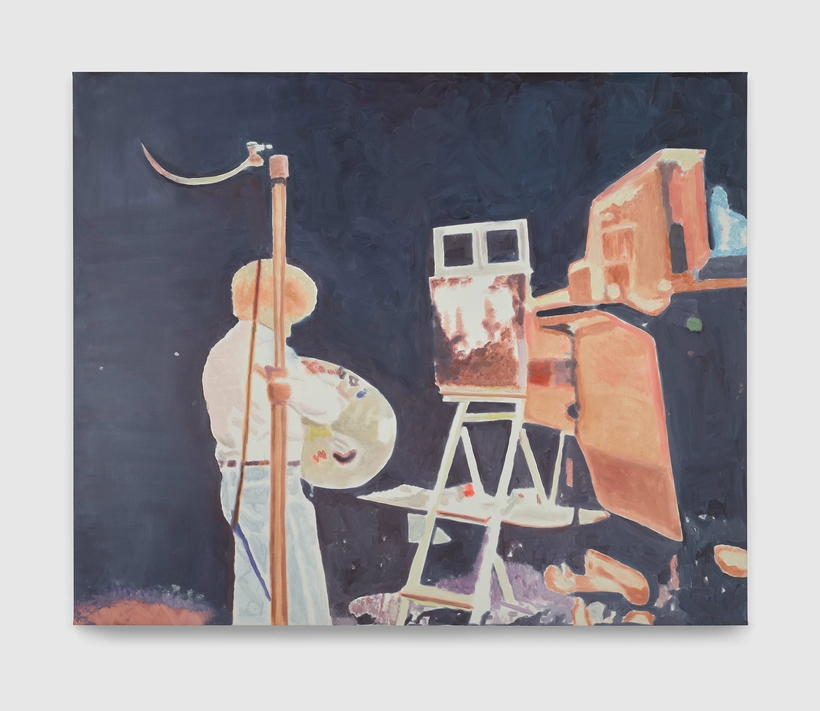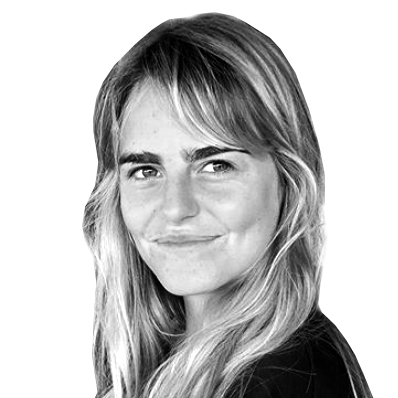The Belgian artist Luc Tuymans came to prominence in the 1990s, when figurative painting was losing its hold in Europe. He kept at it anyway. Tuymans, now 64, looks to photographs for images. When he’s drawn to one, he often re-photographs it before doing a painting, which he almost always finishes in a day. His views on good and evil hide behind the paintwork, and his imagery often examines society’s pitfalls. Ahead of his show “The Barn,” which is on now at David Zwirner on 20th Street, in New York, AIR MAIL met with the artist.
ELENA CLAVARINO: I read that you sometimes think about a subject for months or years before you pick up a brush. Are you actively thinking about it or allowing it to percolate?
LUC TUYMANS: I’m really thinking about it. There are images that I forgot or that because of my proximity to them I didn’t recognize their relevance. I use different things—drawings, the web, my iPhone. I use all those elements in the toolbox, and then I make a painting in a day.
E.C.: That’s very fast. Do you ever revisit a work that you thought you had finished?
L.T.: There are paintings that are more difficult and take up to 12, 14 hours, but it’s nonstop. The minute I close the door of my studio, I know whether it worked or not.
E.C.: How do you choose what you will transform into a painting?
L.T.: Since I mostly work from existing imagery, I must know what the significance of the imagery is. Otherwise, I cannot relate to it. Sometimes, imagery is so compelling that I cannot completely understand why it fascinates me, and therefore I must make it.
E.C.: Do fading, muted colors represent a certain detachment from reality for you, or is it something deeper than that?
L.T.: Tonality is more important than color, because it creates depth. Where I live, a lot of the time it’s gray and very luminescent, so I have a completely different perception of light and shade than if I were in Spain or Los Angeles.

E.C.: I read somewhere that you believe Jan van Eyck to be the most powerful painter in the West. I would imagine Caravaggio would also have captured you with his brand of sinister realism.
L.T.: Back in the 15th century, Jan van Eyck and his brother developed oil painting, which was stolen by Pisanello and enabled Leonardo da Vinci to make his first masterpiece. By making imagery more profane under the cloak of religion, Van Eyck opened up the world to a type of unforgiving realism. His motto was, “If I can.” Behind the fact of humility, there was gigantic ambition. That’s where I come from.
E.C.: And what of Caravaggio?
L.T.: The Italians go from the dark to the light. The Flemish go from the light to the dark.
E.C.: I read that you were kicked out of every art academy. Why is that?
L.T.: Believe it or not, I was very introverted and that was perceived as arrogance and stubbornness by my teachers. I was not rebellious.
E.C.: Tell me about the years you gave up painting, from 1982 to 1986.
L.T.: I stopped painting because it became too existential, too tormented. Then, by accident, a friend gave me a camera and I started making a film. When it became too expensive, I came back to painting. By then, my visual knowledge was informed by the lens. It gave me the right distance.
E.C.: You once said, “I’m not the type of painter that just paints or creates a style, because I think that’s the death of everything.” Can you explain that further.
“There are paintings that are more difficult and take up to 12, 14 hours, but it’s nonstop.”
L.T.: I think the death of art is when it becomes expected. If I’m not nervous before starting to work, I stop because then there’s no point in doing it, except for the money. People really tend to look at artists as geniuses, but it’s just not true. My father made dentures, so he worked with his hands. There was once this anniversary party for one of my sister’s kids, and he glued together a model plane. He had painted camouflage on the wings and written a note. The handwriting was the same as mine. Art is like handwriting, it evolves, but it’s in your DNA.
E.C.: It is often said that the Holocaust is a subject that should be off-limits, that to make art about it diminishes it, yet you keep coming back to the subject and often base your work on the darkest places in history. What are you searching for?
L.T.: I once painted a work based on a watercolor from the real gas chamber in Dachau. If you paint the horror, it doesn’t work. The emptiness is more compelling.
E.C.: What do you think about the state of the world today?
L.T.: We have problems like climate change, but then there is a war in the middle of Europe, which is being dealt with like W.W. I, a war of attrition. This show is about that type of confusion and polarization. I come out of an age group that believed in globalization and a pluralistic society. Now everything is identity driven.
E.C.: Tell me a little bit more about this show.
L.T.: The departure was the barn. I came across it while scrolling. It’s an American barn, so that’s one thing. But then, all of a sudden, I saw my own camera roll underneath it, so that made all the sense in the world. The barn is the element of plentitude, and it’s the idea of assembling good food and all those things, and social media does exactly the same, except that it fucks up the globe. That’s where these things then start.
E.C.: How has the iPhone changed your practice?
L.T.: In 1995, I started to use Polaroids. It’s such bad quality, and you leave a lot of things to chance. A Polaroid is not really a photograph, it’s an emulsion. The iPhone became a tool. You see something, you photograph it, you enlarge it on the phone, and then you can delve into it. It has this low quality, which I like, and which also leaves room for interpretation.
Luc Tuymans: The Barn is on at David Zwirner gallery, on New York’s 20th Street, through July 21
Elena Clavarino is the Senior Editor for AIR MAIL

